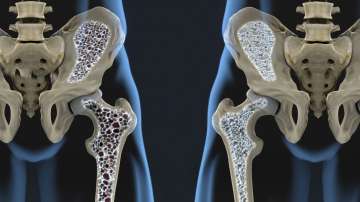The main reason for the weakening of bones is calcium deficiency. With old age, the body starts absorbing calcium and phosphate instead of providing nutrients to the bones. Due to this, the bones become weak. Low bone density leads to osteoporosis and there's always the risk of bone breaking even with a single blow.
Having strong bones is very important for your body. Bones perform many functions such as providing structure, protecting organs, accommodating muscles, and storing calcium. However, it is important to build strong and healthy bones during childhood and adolescence, as after the age of 30, bones cannot absorb as much minerals.
Also Read: Recurring neck pain sign of neck cancer? 5 symptoms to watch out for
In such a situation, weak bones can give rise to osteoporosis disease. This is a condition due to which bones become weak and brittle. Generally, weakening of bones depends on many issues but the most common reasons are increasing age, deficiency of calcium and minerals, sedentary lifestyle, consumption of tobacco and alcohol, obesity, etc.
However, necessary work to strengthen bones should be done by the age of 20. But if you did not pay special attention to your health during this age, then you should not make the mistake of ignoring these 5 signs. This may be a sign of weakening of the bones. After its diagnosis, you can take the measures mentioned here to avoid the consequences.
Pain in lower back
Back pain is one of the most common symptoms of osteoporosis. If you have pain in your lower back, do not make the mistake of ignoring it, it can be a sign of your weakening bones. If it is not treated in time, the chances of bone fracture increases.
Incidence of height
It is normal to lose some height with age but height loss is also a sign of weakening of bones. Many people believe that height loss is a normal process. In which people may be half an inch or three-quarters of an inch shorter. But it is wrong to believe that in people with weak bones, the height reduces by two, three, or four inches. In such a situation, keep checking your height from time to time.
Broken bones
Fractures are closely related to weak bones. About 50 percent of women and 25 percent of men are expected to have an osteoporosis-related fracture in their lifetime due to low bone density. In which the matter of most concern is hip fracture.
Early menopause
Early menopause is a sign of low bone density. When you don't have enough estrogen, bones break down much faster than they are formed. In such a situation, it is essential to discuss the prevention of bone loss with a doctor in case of early menopause.
Difficulty in standing
If you need to use your arms to stand up (for example from a chair) your bones may become weak. Our bones and our muscles work as one unit, they get stronger as a unit and get weaker as a unit. This increases the possibility of falling and low bone density.
Measures for strong bones
To strengthen bones, first of all, eat plenty of calcium and protein-rich foods. Along with this, keep the amount of Vitamin D in the body balanced. Do not consume alcohol and start doing physical activities.

